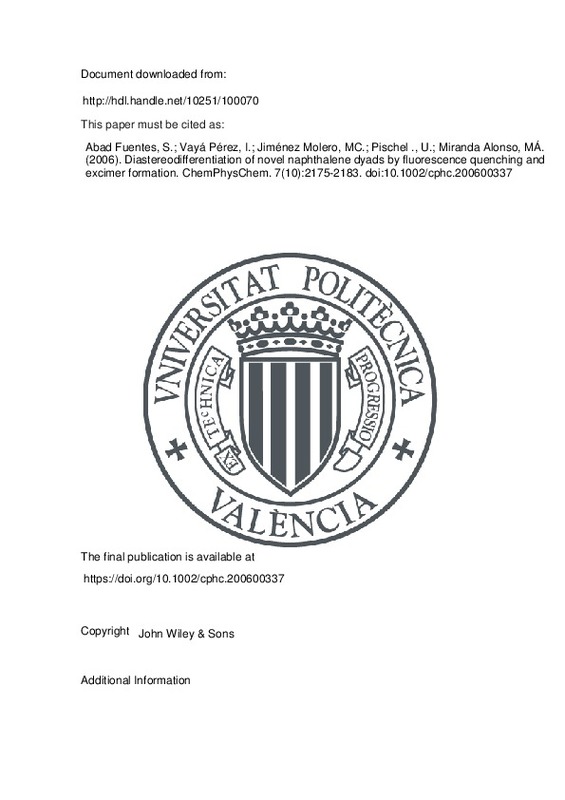JavaScript is disabled for your browser. Some features of this site may not work without it.
Buscar en RiuNet
Listar
Mi cuenta
Estadísticas
Ayuda RiuNet
Admin. UPV
Diastereodifferentiation of novel naphthalene dyads by fluorescence quenching and excimer formation
Mostrar el registro sencillo del ítem
Ficheros en el ítem
| dc.contributor.author | Abad Fuentes, Sergio
|
es_ES |
| dc.contributor.author | Vayá Pérez, Ignacio
|
es_ES |
| dc.contributor.author | Jiménez Molero, María Consuelo
|
es_ES |
| dc.contributor.author | Pischel ., Uwe
|
es_ES |
| dc.contributor.author | Miranda Alonso, Miguel Ángel
|
es_ES |
| dc.date.accessioned | 2018-04-08T04:18:53Z | |
| dc.date.available | 2018-04-08T04:18:53Z | |
| dc.date.issued | 2006 | es_ES |
| dc.identifier.issn | 1439-4235 | es_ES |
| dc.identifier.uri | http://hdl.handle.net/10251/100070 | |
| dc.description.abstract | [EN] Four new bichromophoric naphthalene dyads in form of diastereomeric pairs are synthesized and photophysically characterized. For a closely related group of compounds (NAP-NAP MNAP-NAP, MNAP-MNAP), systematic variation of the urea linker led to the observation of intramolecular fluorescence quenching for tertiary urea, but not for secondary urea. Chiral information contained in the dyads has an impact on the efficiency of this process. Furthermore, for the case of (RR)-MNAP-MNAP excimer formation in the pre-organized dyad was noted, while being absent in the corresponding (R,S) diastereomer. These differences in photophysical behavior are ascribed to the geometry of the linker and to the chiral information contained in the diastereomeric compounds. Other dyads, such as NPX-NPX, included naproxen as the chromophore. For these compounds strong excimer emission is obtained, however, only very small diastereodifferentiation is observed for the two investigated stereoisomers. | es_ES |
| dc.description.sponsorship | We acknowledge the financial support by the Spanish Ministry of Education and Science (Grant No. CTQ 2004-03811, doctoral fellowships for S.A. and I.V., Ramón y Cajal grant for U.P.). | es_ES |
| dc.language | Inglés | es_ES |
| dc.publisher | John Wiley & Sons | es_ES |
| dc.relation.ispartof | ChemPhysChem | es_ES |
| dc.rights | Reserva de todos los derechos | es_ES |
| dc.subject | Chiral recognition | es_ES |
| dc.subject | Electron transfer | es_ES |
| dc.subject | Fluorescence | es_ES |
| dc.subject | Naphthalene | es_ES |
| dc.subject | Photochemistry | es_ES |
| dc.subject.classification | QUIMICA ANALITICA | es_ES |
| dc.subject.classification | QUIMICA ORGANICA | es_ES |
| dc.title | Diastereodifferentiation of novel naphthalene dyads by fluorescence quenching and excimer formation | es_ES |
| dc.type | Artículo | es_ES |
| dc.identifier.doi | 10.1002/cphc.200600337 | es_ES |
| dc.relation.projectID | info:eu-repo/grantAgreement/MEC//CTQ2004-03811/ES/INTERACCIONES FARMACO-BIOMOLECULA EN LOS ESTADOS EXCITADOS/ | es_ES |
| dc.rights.accessRights | Abierto | es_ES |
| dc.contributor.affiliation | Universitat Politècnica de València. Instituto Universitario Mixto de Tecnología Química - Institut Universitari Mixt de Tecnologia Química | es_ES |
| dc.contributor.affiliation | Universitat Politècnica de València. Departamento de Química - Departament de Química | es_ES |
| dc.description.bibliographicCitation | Abad Fuentes, S.; Vayá Pérez, I.; Jiménez Molero, MC.; Pischel ., U.; Miranda Alonso, MÁ. (2006). Diastereodifferentiation of novel naphthalene dyads by fluorescence quenching and excimer formation. ChemPhysChem. 7(10):2175-2183. https://doi.org/10.1002/cphc.200600337 | es_ES |
| dc.description.accrualMethod | S | es_ES |
| dc.relation.publisherversion | https://doi.org/10.1002/cphc.200600337 | es_ES |
| dc.description.upvformatpinicio | 2175 | es_ES |
| dc.description.upvformatpfin | 2183 | es_ES |
| dc.type.version | info:eu-repo/semantics/publishedVersion | es_ES |
| dc.description.volume | 7 | es_ES |
| dc.description.issue | 10 | es_ES |
| dc.relation.pasarela | S\29816 | es_ES |
| dc.contributor.funder | Ministerio de Educación y Ciencia | es_ES |







![[Cerrado]](/themes/UPV/images/candado.png)

